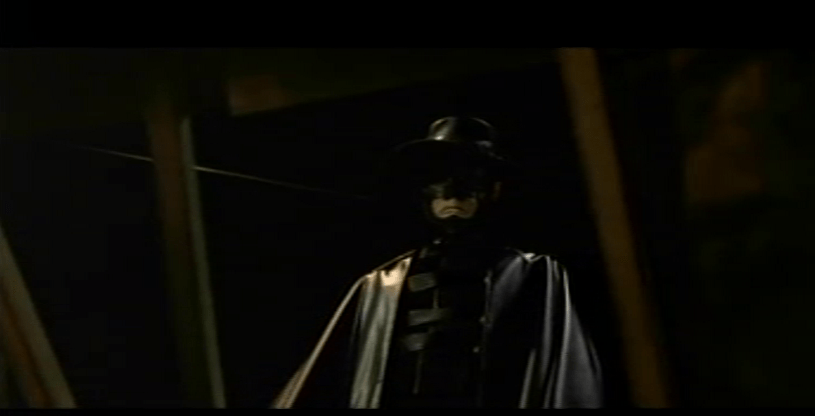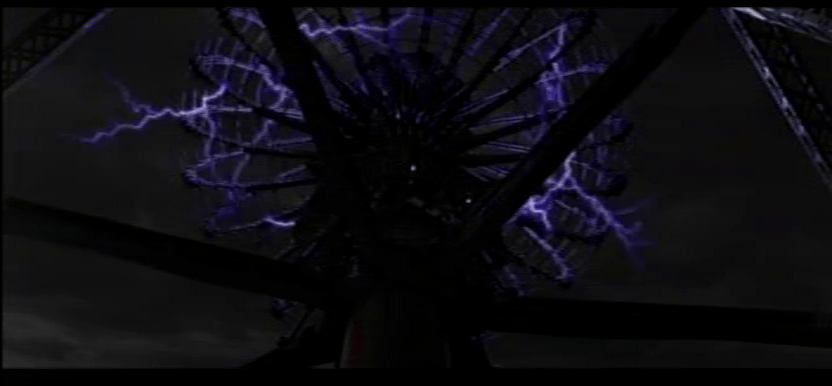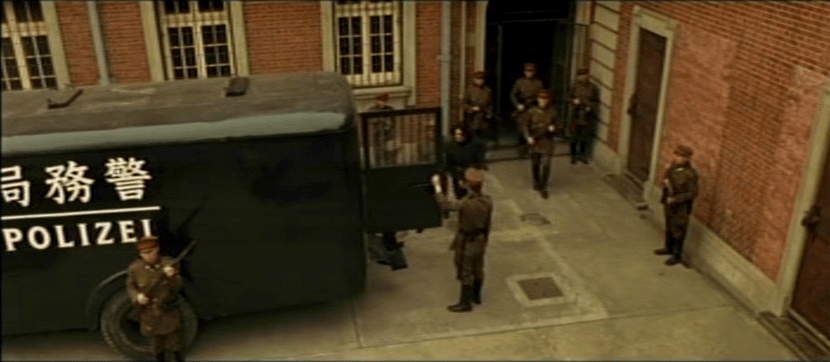 I first looked at K-20 because it was written and directed by a woman, Shimako Sato, expecting something similar to Sway or Wild Berries. Boy, was I surprised. What I found instead was a full Spielbergian extravaganza, full of barely credible derring-do told with the same kind of inventive yet nostalgic recreation of the feeling of a Saturday matinee that powered the Indiana Jones films. This is combined with the look of the Nolan Batman movies or Blade Runner, yet still full of a playfulness not found in those models. Like the later Goemon, it is heavily dependent on CGI yet in contrast remembers that CGI should always be used in service to the story.
I first looked at K-20 because it was written and directed by a woman, Shimako Sato, expecting something similar to Sway or Wild Berries. Boy, was I surprised. What I found instead was a full Spielbergian extravaganza, full of barely credible derring-do told with the same kind of inventive yet nostalgic recreation of the feeling of a Saturday matinee that powered the Indiana Jones films. This is combined with the look of the Nolan Batman movies or Blade Runner, yet still full of a playfulness not found in those models. Like the later Goemon, it is heavily dependent on CGI yet in contrast remembers that CGI should always be used in service to the story.
K-20 greatly benefits from a star made for such a movie – Takeshi Kaneshiro. As the circus acrobat Heikichi drawn unknowingly into the evil plans of K-20, he is open, outgoing, honest, and athletic, all the things you want in an action hero, while still managing to be a convincing babe in the woods when faced by the deviousness of others. Born in Taiwan with a Japanese father, his fluency in Mandarin, Cantonese, and Japanese as well as his nearly 6′ in height and rugged good looks had by this time made him the biggest star in the Asian world after Jackie Chan. Known to Americans primarily for his Chinese movies, he had become equally active in less well-known Japanese movies and TV as a rugged action hero.
K-20, the Fiend with Twenty Faces, was the villain in Edogawa Rampo’s boys’ stories featuring the Boys Detective Club and Detective Akechi. He has already stolen many valuable jewels and works of art and now has targeted a Breughel painting, and Detective Akechi is out to foil the theft. Though he still has his assistant Kobayashi, who uses the Boys Detective Club as informants, this is quite a different Akechi than we have seen before, not a private detective but a senior policeman. He also operates in an alternate world. It is 1949 and there has been no war, meaning that the old military government is still in control and the wealthy families have continued to gobble up the wealth, leaving the rest of the population as poor as they were in the Occupation years, but now driven there by their own ruling class. K-20 is seen as a hero because he robs the rich, though there is no sign of him giving to the poor afterward.
Akechi was always an outsider, though he often cooperated with the police, so it is quite a change to see him high in the police, called a Baron, and set to marry the Duchess Yoko, heir to the largest fortune in the country, in a marriage arranged by her dead father. Heikichi is tricked into setting off a distraction that will allow K-20 to steal the painting and is arrested and charged with being K-20 himself. After an ingenious escape arranged by a group of thieves led by Genji, the man who also makes devices for Heikichi’s act, he sets out to clear his name, which can only be done by unmasking the real K-20.
He trains himself to parkour across the imaginary Tokyo, now called Teito, which will eventually allow him many miraculous escapes. He also rescues Yoko from K-20, as she later rescues him in her open-seater helicopter. K-20 is not really after the painting, for it is a copy, but the secret code under the paint that will tell him where to find the Tesla machine.  When used for good it can provide electricity without wires but when used for evil can make explosions like the atomic bomb which will make its possessor the ruler of the world. (K-20 has an evil villain laugh to match.) Naturally, the Japanese Army is also after this device.
When used for good it can provide electricity without wires but when used for evil can make explosions like the atomic bomb which will make its possessor the ruler of the world. (K-20 has an evil villain laugh to match.) Naturally, the Japanese Army is also after this device.
Since it is based on a 1989 novel that has never been translated, I assume that the plot and setting come from the source. Sato has given it a look that draws from the whole world’s action universe and a pacing that can stand comparison with the best comic book movies. This is aided enormously by the score by Naoki Sato (apparently no relation) that could have come straight from the desk of John Williams in his Indiana Jones mode. In description, it sounds derivative, what with the black capes, the Mission:Impossible latex masks, and the Bond villain who wants to rule the world, but on the screen it speeds along so efficiently that you don’t mind. Only the parkour practice scenes seem to last longer than we need, but unlike Goemon the stunt work itself seems to be done by real people.
The CGI was done by the same team that did Always: Sunset on Third Street and is seamlessly integrated into the real scenery.
In this alternate world there appears to have been no war at all, but the alliance with Germany is still in force, since the police vans are in Japanese and German. There is a touch of anti-nostalgia, like Kabei reminding viewers of what Japan’s military rule really looked like and suggesting that life for ordinary people would have been no better in the forties even if the war had never happened. Still, it’s not a political movie. It’s an entertainment movie. It is a mish-mash of the American action movies just before the Marvel Universe and the look of the Wachowskis became so dominant and of a Japanese popular cultural tradition built around the Akechi characters so beloved by boys in the forties.
It also indicates again just how much American movies had penetrated Japanese popular culture. Curiously, though the movie did very well at the box-office, considerably better than Goemon, it was still out drawn by the real foreign product like Harry Potter or Transformers, and even Mamma Mia and Benjamin Button, and far less popular than Kaneshiro’s other movie of the year, Red Cliffs II. It was also did worse than many anime features from the Pokemon, Detective Conan, and Evangelion franchises that seemed indestructible. Perhaps because it had a real and very busy star and a budget, a series never materialized.*
* Detective Conan, with 25 animated films so far, as well as multiple TV anime series, is obviously based on the Detective Akechi series. Conan is an elementary schoolboy who calls himself Edogawa Conan and solves cases for a real police detective with the help of the Junior Detective League, This of course is nowhere near the fifty or so live action Kamen Rider movies, not counting the thirty-odd TV series, but it illustrates that the Japanese audience was still as loyal to series films as in the fifties and sixties, though most of these were aimed at a children’s audience.

